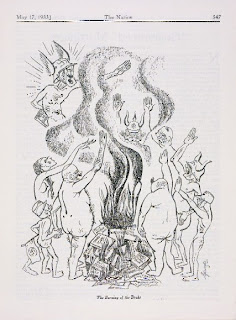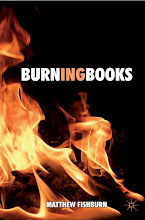The original novel by King was released in this limited edition of 26 copies, bound in aluminium-coated asbestos cloth. Known as the "Asbestos Firestarter", it was produced in honour of the earlier asbestos-bound limited edition of Ray Bradbury's Fahrenheit 451.
Friday, September 18, 2009
Stephen King: Firestarter
The original novel by King was released in this limited edition of 26 copies, bound in aluminium-coated asbestos cloth. Known as the "Asbestos Firestarter", it was produced in honour of the earlier asbestos-bound limited edition of Ray Bradbury's Fahrenheit 451.
Thursday, September 17, 2009
Burning Bookmark: now only $3
 Now available via the internet: the burning bookmark.
Now available via the internet: the burning bookmark.The copy-writers have had a field day with this one: "Are you diving into a smoldering novel? Browsing through some incendiary literature? Give the book-burning-bunch something to get hot about with this flaming placeholder. Wedge it snugly between the pages of your favorite edition of “Fahrenheit 451” and let this stylized flame show you quickly to your saved spot. You don't have to burn books to destroy a culture. Just get people to stop reading them!"
http://www.perpetualkid.com/index.asp?PageAction=VIEWPROD&ProdID=3138
Wednesday, August 26, 2009
Books as Decoration?
 This seems almost too wonderful to be true, but a woman on the interweb is encouraging people to jazz up their family snaps by collaging them onto a background of ripped up books, in this case a thesaurus that was asking for it. Wonderful.
This seems almost too wonderful to be true, but a woman on the interweb is encouraging people to jazz up their family snaps by collaging them onto a background of ripped up books, in this case a thesaurus that was asking for it. Wonderful.http://www.designspongeonline.com/2009/08/diy-project-kat-geigers-modern-family-photos.html/july-2009-011
Wednesday, July 15, 2009
Books as decoration: Vinothek
Tuesday, July 7, 2009
On Papetoai
‘In one of the visits which Mr. Nott made to the residence of Taaroarii, for the purpose of preaching to his people, he was followed by Patii, the priest of the temple in Papetoai, the district in which the missionaries resided. This individual appeared to listen most attentively to what was said; and after the conclusion of the service, he and Mr. Nott proceeded together along the beach towards the settlement.As they walked, Patii fully disclosed the feelings of his mind to Mr. Nott, and assured him that on the morrow, at a certain hour, he would bring out the idols under his care, and publicly burn them. […]
Patii, however, was punctual to his word. He, with his friends, had collected a quantity of fuel near the sea-beach; and, in the afternoon, the wood was split, and piled on a point of land in the western part of Papetoai, near the large national Marae, or temple, in which he had officiated. […]
A short time before sun-set, Patii appeared, and ordered his attendants to apply fire to the pile. This being done, he hastened to the sacred depository of the gods… When he approached the burning pile, he laid them down on the ground. They were small carved wooden images, rude imitations of the human figure; or shapeless logs of wood, covered with finely braided and curiously wrought cinet of cocoa-nut fibres, and ornamented with red feathers. […]
Patii tore off the sacred cloth in which they were enveloped, to be safe from the gaze of vulgar eyes; stripped them of their ornaments, which he cast into the fire; and then one by one threw the idols themselves into the crackling flames – sometimes pronouncing the name and pedigree of the idol, and expressing his own regret at having worshipped it – at others, calling upon the spectators to behold their inability even to help themselves. Thus were the idols which Patii, who was a powerful priest in Eimeo, had worshipped, publicly destroyed.’
Reverend William Ellis, Polynesian Researches, During a Residence of Nearly Six Years in the South Sea Islands (London, 1829)
Patii, however, was punctual to his word. He, with his friends, had collected a quantity of fuel near the sea-beach; and, in the afternoon, the wood was split, and piled on a point of land in the western part of Papetoai, near the large national Marae, or temple, in which he had officiated. […]
A short time before sun-set, Patii appeared, and ordered his attendants to apply fire to the pile. This being done, he hastened to the sacred depository of the gods… When he approached the burning pile, he laid them down on the ground. They were small carved wooden images, rude imitations of the human figure; or shapeless logs of wood, covered with finely braided and curiously wrought cinet of cocoa-nut fibres, and ornamented with red feathers. […]
Patii tore off the sacred cloth in which they were enveloped, to be safe from the gaze of vulgar eyes; stripped them of their ornaments, which he cast into the fire; and then one by one threw the idols themselves into the crackling flames – sometimes pronouncing the name and pedigree of the idol, and expressing his own regret at having worshipped it – at others, calling upon the spectators to behold their inability even to help themselves. Thus were the idols which Patii, who was a powerful priest in Eimeo, had worshipped, publicly destroyed.’
Reverend William Ellis, Polynesian Researches, During a Residence of Nearly Six Years in the South Sea Islands (London, 1829)
Friday, July 3, 2009
On Raiatea
The missionary ‘Papeiha requested the people to attend a general meeting which was to be held on the following morning… At the appointed hour, the whole of the inhabitants of the island assembled, and, after having spoken to them of the immense labour they formerly bestowed in the erection of the maraes, and in the worship of their gods, he exhorted them to let their “strength, devotedness, and steadfastness in the service of the true God, far exceed.” He then made the following two propositions: first, “That all the maraes in the island should be burned, and that all the remaining idols should be brought to him, in order that he might forward them to us at Raiatea, that we, with our people, might also rejoice in the triumphs of the word.” The second proposition was, “That we should commence immediately building a house in which to worship Jehovah.” To both these proposals the assembled multitude yielded their cordial assent. As soon as the meeting broke up, a general conflagration of the maraes took place; and so complete was the destruction, that, on the following morning, not a single idol temple remained unmutilated.’
John Williams, A Narrative of Missionary Enterprises in the South Sea Islands (London, 1838)
John Williams, A Narrative of Missionary Enterprises in the South Sea Islands (London, 1838)
Tuesday, May 12, 2009
Books as decoration
 My new hobby is to keep an eye on how books are increasingly being used as decorations. There was a fashion for this in the interwar years, when people took fancy old bindings and made them into cigarette cases, but now people are being much more imaginative. Certainly if the glossy magazines are to be trusted, the only thing books are good for is to hold up shells and small antiques (although I have a sneaking admiration for another design favourite, people who sort their books by the colour of their binding).
My new hobby is to keep an eye on how books are increasingly being used as decorations. There was a fashion for this in the interwar years, when people took fancy old bindings and made them into cigarette cases, but now people are being much more imaginative. Certainly if the glossy magazines are to be trusted, the only thing books are good for is to hold up shells and small antiques (although I have a sneaking admiration for another design favourite, people who sort their books by the colour of their binding).http://www.apartmenttherapy.com/sf/look/look-counter-made-from-books-083986
Thursday, May 7, 2009
Erasing cigarettes
 A friend sent through a link to this recent article in the Sydney Morning Herald, which is a bit of a stretch, but I think has a natural home here on the blog. Apparently Manly Council has gone around its digital collection of paintings by the smoking enthusiast Antonio Dattilo-Rubbo rubbing out the cigarettes. My hope is that they bring the same zeal to author photos of the same era, and appoint an official to go through the municipal libraries scratching out the offensively dangling Gitanes that have been the preferred prop of the author for generations.
A friend sent through a link to this recent article in the Sydney Morning Herald, which is a bit of a stretch, but I think has a natural home here on the blog. Apparently Manly Council has gone around its digital collection of paintings by the smoking enthusiast Antonio Dattilo-Rubbo rubbing out the cigarettes. My hope is that they bring the same zeal to author photos of the same era, and appoint an official to go through the municipal libraries scratching out the offensively dangling Gitanes that have been the preferred prop of the author for generations.Monday, February 23, 2009
Burn all your books: Voltaire
Voltaire, who had already had any number of his books burned in Paris, Geneva and Rome, published his Dictionnaire Philosophique in 1764, to the by now typical reaction from authorities. The book was banned and burned, and even owning a copy was considered dangerously close to sedition.
Interestingly, Voltaire is a good example of how common the rhetoric of book burning was in the eighteenth-century. In his entry on “War” in the Dictionnaire Philosophique, he wrote:
“Wretched physicians of souls, you declaim for five quarters of an hour about some pinprick, and you say nothing about the disease that tears us into a thousand pieces! Philosophical moralists, burn all your books. So long as the whim of a few men causes thousands of our brothers to be honourably butchered, the portion of mankind devoted to heroism will be the most frightful thing in the whole of nature.”
Interestingly, Voltaire is a good example of how common the rhetoric of book burning was in the eighteenth-century. In his entry on “War” in the Dictionnaire Philosophique, he wrote:
“Wretched physicians of souls, you declaim for five quarters of an hour about some pinprick, and you say nothing about the disease that tears us into a thousand pieces! Philosophical moralists, burn all your books. So long as the whim of a few men causes thousands of our brothers to be honourably butchered, the portion of mankind devoted to heroism will be the most frightful thing in the whole of nature.”
Friday, January 30, 2009
Burning Manuscripts: Tom Paulin
It’s a favourite habit of writers to become nervous about their early writings. I was reading Tom Paulin’s The Invasion Handbook the other day, a work which sent me rummaging around on google, trying to follow some of the more difficult leads. I ended up looking at a few interviews with Paulin, including this one from the Guardian in 2002, in which he alludes to an earlier trip to the incinerator:
‘By the time Paulin left school he knew he wanted to write, and when he went to Hull University to read English in 1967 it was with the express intent of later returning to Belfast for a teaching job that would allow time to write. “But I didn't get anywhere with my writing at Hull,” he explains, and describes his early unpublished work as “inchoate”. He later burnt it all. “Maybe I am not so happy about that now. It was something I did in my 20s. You go through a bad time and think ‘where am I going?’. And I thought I would just clean everything out.”’
Nicholas Wroe, The Guardian 23 March 2002
http://www.guardian.co.uk/books/2002/mar/23/poetry.academicexperts
‘By the time Paulin left school he knew he wanted to write, and when he went to Hull University to read English in 1967 it was with the express intent of later returning to Belfast for a teaching job that would allow time to write. “But I didn't get anywhere with my writing at Hull,” he explains, and describes his early unpublished work as “inchoate”. He later burnt it all. “Maybe I am not so happy about that now. It was something I did in my 20s. You go through a bad time and think ‘where am I going?’. And I thought I would just clean everything out.”’
Nicholas Wroe, The Guardian 23 March 2002
http://www.guardian.co.uk/books/2002/mar/23/poetry.academicexperts
Wednesday, January 28, 2009
1933: The Nation
 Curiously, although there were many cartoons on the Nazi bookfires in 1933, the majority of them were openly mocking. The Nation, the left-leaning American weekly was no exception, publishing this cartoon by Georges Schreiber in which a group of moustachioed militarists, industrialists and SA men caper about in the nude, looking something like a George Grosz caricature. Hitler looms large over the pyre, holding a copy of the works of de Sade, while on the fire are copies of the Old Testament, the Nation itself, and the writings of Thomas Mann burn (Thomas Mann, of course, was not on the first Nazi blacklists). What the juxtaposition implies, of course, is that the wrong books are being burned, while the decrepit figures suggest the bankruptcy of their ideas.
Curiously, although there were many cartoons on the Nazi bookfires in 1933, the majority of them were openly mocking. The Nation, the left-leaning American weekly was no exception, publishing this cartoon by Georges Schreiber in which a group of moustachioed militarists, industrialists and SA men caper about in the nude, looking something like a George Grosz caricature. Hitler looms large over the pyre, holding a copy of the works of de Sade, while on the fire are copies of the Old Testament, the Nation itself, and the writings of Thomas Mann burn (Thomas Mann, of course, was not on the first Nazi blacklists). What the juxtaposition implies, of course, is that the wrong books are being burned, while the decrepit figures suggest the bankruptcy of their ideas.
Subscribe to:
Posts (Atom)


